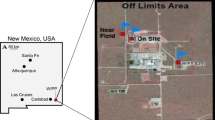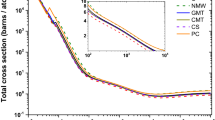Abstract
Three years ago, the Waste Isolation Pilot Plant (WIPP) experienced its first minor accident involving a radiological release. Late in the evening on February 14, 2014, a waste container in the repository underwent a chemical reaction that caused the container to overheat and breach, releasing its contents into the underground. Following a lengthy recovery process, the facility recently resumed waste disposal operations. The accident released significant levels of radioactivity into the disposal room and adjacent exhaust drifts, and although no one was present in the underground at the time of the release, a total of 22 workers tested positive for very low level of radiation, presumably from some of the radioactive material that was released above ground through a small leak in the HEPA filtration system. The dominant radionuclides released were 241Am and 239 + 240Pu in a ratio that matched the content of the drum from Los Alamos National Laboratory (LANL) that was eventually identified as the breached container. From the air particulate monitoring and plume modeling, it was concluded that the dose, at the nearest location accessible to the general public, from this radiation release event would have been less than 0.01 mSv (< 1 mrem/year). This level is well below the 0.1 mSv/year (10 mrem/year) regulatory limit for DOE facilities established by the US Environmental Protection Agency (EPA).
While no long-term impacts to public health or the environment are expected as a result of the WIPP radiation release, the limited ventilation and residual contamination levels in the underground are still a concern and pose a major challenge for the full recovery of WIPP. This article provides an up-to-date overview of environmental monitoring results through the WIPP recovery and an estimate of the long-term impacts of the accident on the natural and human environment.







Similar content being viewed by others
References
ASER (2014) Waste isolation pilot plant annual site environmental report for 2014. DOE/WIPP-15-8866. www.wipp.energy.gov/library/aser/DOE
ASER (2016) Waste isolation pilot plant annual site environmental report for 2016 DOE/WIPP-17-3591. www.wipp.energy.gov/library/aser/DOE
Carlsbad Environmental Monitoring & Research Center (CEMRC). Annual report-2015 www.cemrc.org/annual
Faller F (1994) Residual soil radioactivity at the gnome test site in Eddy County, New Mexico, report no. EPA 600/R-94/117. Washington, DC, Environmental Protection Agency http://www.wipp.energy.gov/Special/AIB_Final_WIPP_Rad_Release_Phase1_04_22_2014.pdf
Giaquinto JM (2014) RE: WIPP-HEPA MOD–filter dose rate can be used to estimate release source term, e-mail communication to C.H Hunter, December 11, 2014
Hayes RB (2014) February 14th, contamination release consequence assessment. Rev. 1,” 8 March 2014, Nuclear Waste Partnership, available online at: http://www.wipp.energy.gov/Special/Modeling%20Results.pdf
Hayes RB (2016) Consequence assessment of the WIPP radiological release from February 2014. Health Phys 110:342–360
Hunter CH, Viner BJ (2015) Radiological source term estimates for the February 14, 2014 WIPP release event. SRNL-STI-2014-00579
Ionization radiation exposure of the population of the United States (2009) NCRP No. 160, National Council on Radiation Protection and Measurements, Bethesda, MD
Kenney JW, Downes PS, Gray DH, Ballard SC (1995) Radionuclide baseline in soil near project gnome and the waste isolation pilot plant. Environmental Evaluation Group, EEG-58
Kenney JW, Gray DH, Ballard SC, Chaturvedi L (1999) Preoperational radiation surveillance of the WIPP Project by EEG from 1996–1998. EEG-73
Poppiti J, Nelson R, MacMillan WJ, Scott Cunningham S (2017) Analysis of a radioactive release in a nuclear waste disposal facility. DOE-EM-4.21-02, July, 2017
TAT-Report (2015) Waste Isolation Pilot Plant Technical Assessment Team Report. http://www.wipp.energy.gov/Special/TECHNICAL_ASSESSMENT_TEAM_REPORT.pdf
Thakur P, Lemons BG, Ballard S, Hardy R (2015) Environmental and health impacts of February 14, 2014 radiation release from the nation’s only deep geologic nuclear waste repository. J Environ Radioact 146:6–15
Thakur P, Lemons BG, White CR (2016) The magnitude and relevance of the February 2014 radiation release from the Waste Isolation Pilot Plant repository in New Mexico, USA. Sci Total Environ 565:1124–1137
U.S. EPA (2000) National Primary Drinking Water Regulations; Radionuclides; Final Rule, 40 CFR Parts 9, 141, and 142. Federal Register 65, No. 236, 76708-76753
USAEC (1963) Gnome/Coach Site Disposal Options. U.S. Atomic Energy Commission NVO-131, Las Vegas, NV
US-DOE (2014) U.S. Department of Energy Accident Investigation Report, Phase-I. Radiological release event at the Waste Isolation Pilot Plant on February 14, 2014. Washington, DC: U.S. Department of Energy. Accessible at: www.wipp.energy.gov/.../AIB_Final_WIPP_Rad_Release_Phase1_04_22
US-DOE (2015) U.S. Department of Energy Accident Investigation Report, Phase -II. Radiological Release Event at the Waste Isolation Pilot Plant on February 14, 2014. Washington, DC: U.S. Department of Energy. Accessible at: http://www.wipp.energy.gov/Special/AIB_WIPP%20Rad_Event%20Report_Phase%20II.pdf
Funding
This research is supported by grant from US Department of Energy, Carlsbad Field Office of DOE through Grant No. DE-EM 0002423.
Author information
Authors and Affiliations
Corresponding author
Additional information
Responsible editor: Georg Steinhauser
Rights and permissions
About this article
Cite this article
Thakur, P., Runyon, T. Ongoing environmental monitoring and assessment of the long-term impacts of the February 2014 radiological release from the waste isolation pilot plant. Environ Sci Pollut Res 25, 17038–17049 (2018). https://doi.org/10.1007/s11356-018-1795-7
Received:
Accepted:
Published:
Issue Date:
DOI: https://doi.org/10.1007/s11356-018-1795-7




